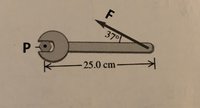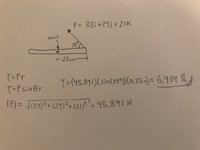You are using an out of date browser. It may not display this or other websites correctly.
You should upgrade or use an alternative browser.
You should upgrade or use an alternative browser.
Calcule the torsion force
- Thread starter elleo_88
- Start date
Harry_the_cat
Elite Member
- Joined
- Mar 16, 2016
- Messages
- 3,754
Check out this video:

 www.khanacademy.org
www.khanacademy.org

Finding torque for angled forces (video) | Khan Academy
David explains how to determine the torque exerted by a non-perpendicular force.
D
Deleted member 4993
Guest
Something got lost in translation.There is a wrench that is 25 cm long and a force F= 33i+24j+21k is applied with an angle of 37 degrees like is shown in the picture
Calculate the magnitude of the force of the torque in the point P
Is the problem asking for the magnitude of the "torque" vector (generated by the force and the "arm" vectors)?
Yes, the magnitude of the torque vector in the point PSomething got lost in translation.
Is the problem asking for the magnitude of the "torque" vector (generated by the force and the "arm" vectors)?
D
Deleted member 4993
Guest
Have you watched the video referenced in response #2?Yes, the magnitude of the torque vector in the point P
What is the arm-vector (r) of the torque?
What is the force (F) vector? What is the magnitude of the force vector?
What is the cross-product of those two vectors (T = r X F) - That is your torque vector.
Now calculate the Magnitude of T. (in lots of problems "units" will be involved).
If you are stuck, show us your work and tell us exactly where you are stuck.
I watched the video but the example is when you have the scalar magnitude of the force, like 10 N but I have a vector instead, so I tried to calculate the absolute value of the vector and use that like the magnitudeHave you watched the video referenced in response #2?
What is the arm-vector (r) of the torque?
What is the force (F) vector? What is the magnitude of the force vector?
What is the cross-product of those two vectors (T = r X F) - That is your torque vector.
Now calculate the Magnitude of T. (in lots of problems "units" will be involved).
If you are stuck, show us your work and tell us exactly where you are stuck.
see the attached image
I don’t know if I’m right
Attachments
D
Deleted member 4993
Guest
Do you know how to take a "cross-product" of vectors?I watched the video but the example is when you have the scalar magnitude of the force, like 10 N but I have a vector instead, so I tried to calculate the absolute value of the vector and use that like the magnitude
see the attached image
I don’t know if I’m right
Have you attached the correct picture with the problem?
For your problem, which way is the unit vector i pointed?
1. Yes, but how I am going to use that if I have only one vector?Do you know how to take a "cross-product" of vectors?
Have you attached the correct picture with the problem?
For your problem, which way is the unit vector i pointed?
2. Yes, is the correct picture
3. I think upwards, becasue the force is in that way
D
Deleted member 4993
Guest
This problem statement - with the given picture is incomplete.1. Yes, but how I am going to use that if I have only one vector?
2. Yes, is the correct picture
3. I think upwards, because the force is in that way
The problem states that F= 33i+24j+21k
For that statement to be useful, directions of i, j & k must be fixed
From the definition of F, this is a 3-D problem. Without defining a plane, the angle 37o is redundant in conjunction with the given F= 33i+24j+21k
Force F does not have a designated unit.
If the problem as you have posted, has come from a book or other printed material, please post the COMPLETE problem.


